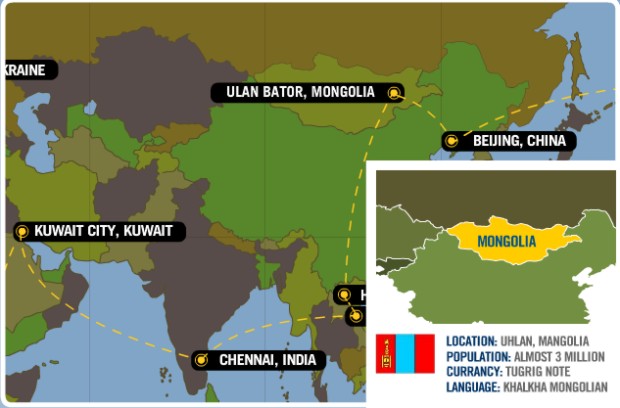|
|
 |
|
|
 |
 |
|
|
 |
 |
 |
|
Mongolia's capital city, Ulan Bator was founded in 1639. The original location of the city was some 400 kilometers from the present day site, having moved to various places along the Selenga, Orhon and Tuul rivers until reaching its present location in the late 18th century.
Ulan Bator, also known as Urga throughout history, is the holy city of the Mongols and the residence of the "Living Buddha," who resides in a sacred quarter on the western side of town. In the 19th century, the city prospered as a commercial center on the tea route between Russia and China and was the seat of the Qing Amban, the highest imperial official in Mongolia. Life changed for the people of Ulan Bator upon the collapse of the Manchu Empire in 1911. Mongolia proclaimed its independence and the city was named capital of the new Mongolian People's Republic in 1924. There are three distinct quarters in the old city: the Kuren or monastery, the residence of the "Living Buddha"; the Mongol city proper, which was home to some 13,000 monks in the early 20th century; and the Chinese town, the great trading quarter, two or three miles from the Mongol quarter, where the houses are more substantially built than in the Mongol town, and the streets have a well-to-do appearance.
Getting to Ulan Bator is surprisingly easy, as the city is served by the Chinggis Khaan International Airport, several major roads and by rail via the Trans-Siberian railway. Traveling around the city is not only economical, but a great way to mingle with the locals. Bus fares are regulated at about 200 tugrig; microbuses charge about 400 tugrig; taxicab fares are metered.
|
|
|
Cultural and Education Centers
Ulan Bator has five major universities: the National University of Mongolia, University of Art and Culture, Pedagogical University, the Science and Technological University of Mongolia, and the University of Health and Medical Science. For visitors and history buffs, a must-see attraction is the city's main library, as it contains a wealth of ancient Mongolian, Chinese and Tibetan manuscripts. The Natural History Museum is another must-see attraction for its collection of ancient artifacts and anthropological finds.
Sühbaatar's Mausoleum
Built in 1921, Sühbaatar's Mausoleum was originally located on the northern side of Sühbaatar Square. Damdin Sühbaatar was a Mongolian war hero in the early 20th century when Mongolia was fighting for its independence. Sühbaatar was buried in the mausoleum after his death in 1923. He was joined by Horloogiyn Choybalsan, the ruler of Mongolia during the Communist Era in the late 20th century. In 2005, the mausoleum was relocated to a graveyard outside of the city to make place for a center dedicated to Chinggis Khaan.
The Winter and Summer Palaces of Bogd Khan
The Bogd Khan Winter Palace and Summer Prayer Temples were built in 1905 by the last of the Bogd Gegeens to live in Mongolia. The two-story wood-framed Winter Palace was constructed according to the designs of a Russian architect working under direct orders of the Russian Czar Nicholas II. The Bogd Gegeen and his consort Dondogdulam lived in the palace for almost 20 winters.
The original Summer Palace burned down sometime in the late 1800s. The current complex of seven temples, located in a walled compound just to the west of the Winter Palace, was constructed between 1893 and 1906. In front of the complex is a wall of blue bricks known as the Yampai, or Spirit Shield, a standard feature of Tibeto-Mongolian temples, which is supposed to deter malignant influences from entering the temple grounds. Just behind this wall is the Three Open Gates, three wooden gateways which remained permanently open in order to allow all good influences to enter the temple compound. The Peace Gate is an elaborate wooden structure built for the Bogd Gegen between 1912 and 1919 to commemorate his ascension to Monarch of Mongolia following the collapse of the Qing Dynasty and the declaration of Mongolian independence.
|
 |
|
|
 |
 |
 |
|




